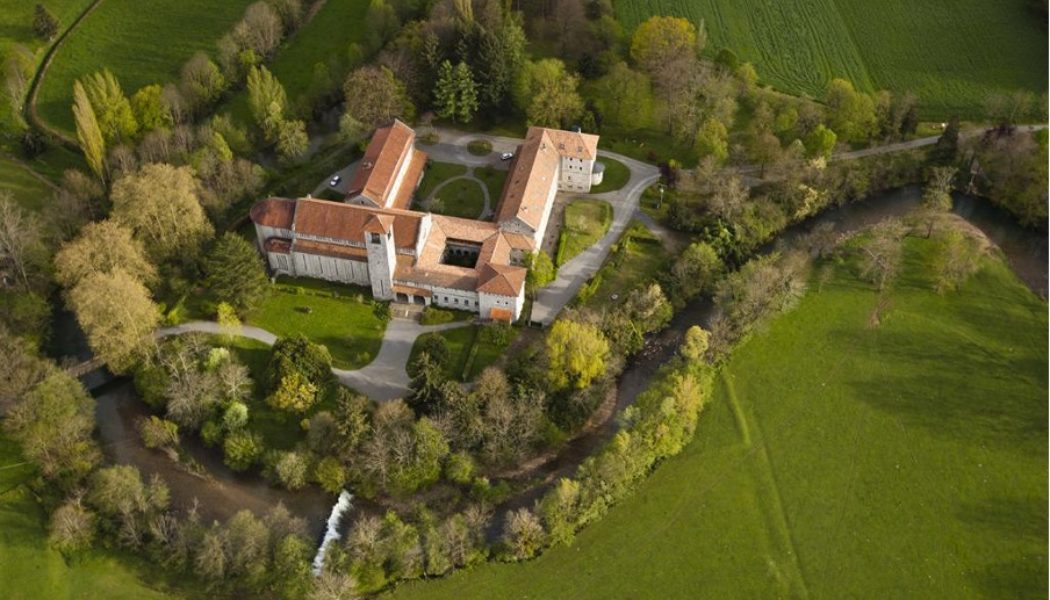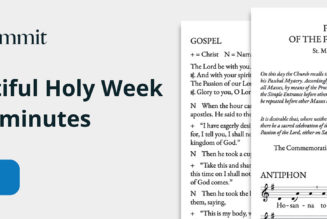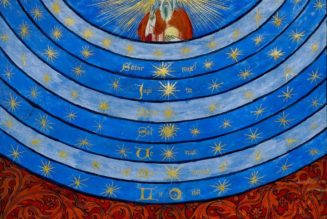Welcome to the abbey Notre-Dame de Tournay in the Hautes-Pyrénées, in France!
Rebuilt in 1951, its history began recently, but its roots are much older. Eighteen Benedictine monks live there today. They follow the rule of Saint Benedict: “Pray and work.”
Below, we will take you on a little tour of the place!

Ten centuries of history
Tournay Abbey’s roots go back to the 11th century when the monastery was built in the commune of Madiran, France.
But in the 17th century, the monastery was abandoned. It was not until the early 1930s that France’s Abbey of En-Calcat bought back the ruined buildings.
In 1934, En-Calcat monks arrived in small groups Madiran to establish a stable monastic life. In 1939, the priory of Madiran became autonomous, but the community quickly dispersed during World War II.
In 1941, the monks returned to Madiran and resumed their monastic life. The community flourished and vocations poured in, so finding new buildings became necessary to accommodate everyone.
Additionally, the region was quite arid and isolated from any means of communication. Transferring the community to another abbey became necessary.
After a long search, the Madiran finally found a 12-acre plot of land, located near Arros river, about 18.5 miles from Lourdes, France.
More precisely, and as you guessed it, in Tournay!
Building Tournay Abbey
The Benedictines laid Tourney abbey’s first stone in 1951. In August 1952, the first mass was celebrated there. The guest house was built in 1955, and the monastery wing in 1964.
The community later created a foundation in Goiás, Brazil in the early 1970s, thanks to its dynamism!

The Benedictines of Tournay of Today
Today, 18 brothers live at the abbey. They meet in the church five times per day to sing the offices. They also listen to the Abbot’s teachings or meet for fraternal exchanges several times per week in the chapter house.
The Brazilian foundation closed in 2009, so several of the Brazilian brothers joined them during that time.
The brothers work the remainder of the day in the different services necessary for the life of the monastery, such as working in the confectionery workshop developing a monastic handicraft of fruit pastes or working in the religious bookshop.
The brothers, faithfully following their hospitable vocation, also continue to welcome guests throughout the year.
To visit the monastery’s guesthouse, each tourists first cross the Arros river on a wooden bridge. This symbolizes the break with the rest of the world, because the monks choose to remain away from the world to better dedicate their lives to God.

The Monk’s Fruit Jellies
Since 1971, Tournay Abbey has been making abbey fruit jellies.
The brothers work in their small artisanal workshop, where each monk has an assignment. Some peel, cook, pack, ship, etc. This allows them to meet their financial needs, which the monastic rule of St. Benedict requires – you must live from your work!
For each of the 17 fruit jelly flavors, the brothers choose “pure fruit” production, meaning, they make everything from the fruit pulp!
This may seem normal, but very often, the fruit jellies you find in the shops are apple puree with added coloring and flavoring.
At Tournay, it’s 100% natural, and directly comes from the concerned fruit!

How to Visit the Tournay Abbey and the fruit jellies
To visit Tournay abbey, cross the small wooden bridge. The community welcomes all wishing to stay or rest for a few days.
It is also possible to ask a brother for help and to participate in the community’s prayers. Click here to learn how to visit and learn more about the abbey.
Products of Tournay Abbey are also available on the Divine Box website.
Follow ChurchPOP:
Telegram Channel
Truth Social
GETTR
Gab
Parler
Signal Group
WhatsApp Group 1
WhatsApp Group 2
ChurchPOP Facebook Group
Email List
[See also: When Trappist Nuns Rebuilt a Monastery from Ruins & Opened a Chocolate Factory]
[See also: The Fascinating History of a Monk-Brewed Beer: Founding of a World-Famous Trappist Brewery]
Comments
comments
Do you love Churchpop?
Get our inspiring content delivered to your inbox – FREE!
Como parte de este servicio gratuito, podría recibir ocasionalmente ofertas de EWTN News y EWTN. Nunca alquilaremos o venderemos su información y usted se puede desuscribir en cualquier momento.
Join Our Telegram Group : Salvation & Prosperity









